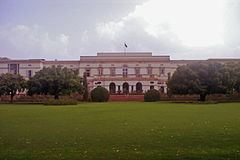Completed 1930 | ||
 | ||
Similar Nehru Planetarium, Tomb of Safdarjung, National Museum - New Delhi, Purana Qila, National Rail Museum | ||
Remembering the legacy of india s first pm from teen murti bhavan
The Teen Murti Bhavan (Teen Murti House) is the former residence of the first Prime Minister of India, Jawaharlal Nehru in Delhi, India, who stayed here for 16 years until his death on May 27, 1964. It was designed by Robert Tor Russell, the British architect of Connaught Place and of the Eastern and Western Courts on Janpath during the British Raj. Teen Murti Bhavan was built in 1930 as part of the new imperial capital of India, New Delhi as the residence of the Commander-in-Chief of the British Indian Army.
Contents
- Remembering the legacy of india s first pm from teen murti bhavan
- Map of Teen Murti Bhavan Teen Murti Marg Area New Delhi Delhi 110011
- Teen murti bhavan visit here for memoirs of nehru
- Etymology
- History
- Details
- References
Map of Teen Murti Bhavan, Teen Murti Marg Area, New Delhi, Delhi 110011
Today, Teen Murti houses various institutions including the Nehru Memorial Museum and Library (NMML), which runs under the Indian Ministry of Culture, and has Dr. Karan Singh as the chairman of its Executive Council. The complex also houses the offices of the 'Jawaharlal Nehru Memorial Fund', established in 1964 under the Chairmanship of Dr S. Radhakrishnan, then President of India. Teen Murti Bhavan also contains a number of mementos from various nations including England, Nepal, Somalia, China, etc. Each memento represents a notable resource of each nation. The foundation also awards the 'Jawaharlal Nehru Memorial Fellowship', established in 1968.
Also contained within the complex are the ‘Centre for Contemporary Studies’ and the Nehru Planetarium which opened in 1984.
Teen murti bhavan visit here for memoirs of nehru
Etymology
The house is named after the Teen Murti (literally "three statues") Memorial by British sculptor, Leonard Jennings, which stands on the road junction in front of its extensive grounds. The memorial comprises life-size statues of three soldiers, and was built in 1922 in the memory of the Indian soldiers from three Indian princely states, namely; Jodhpur State, Hyderabad State and Mysore State who served present day Gaza Strip, Israel, Palestine during the World War I under British India Army.
History
The Bhavan was originally known as 'Flagstaff House' and was the residence of the Commander-in-Chief of the British Forces in India. Situated in a 30-acre estate, the building is constructed of white stone and stucco, and faces the south side of the Rashtrapati Bhavan (Presidents House). It has arched entrance, recessed window, and the first floor has a pillared veranda on the back on the building which overlooks the lawns.
After Independence (1947) the house was taken over as the residence of the Prime Minister. On Nehru's death in 1964, the house was converted into a national memorial comprising a library and a museum. Today, in a ground floor room of the Nehru Museum, his South Block office in the Ministry of External Affairs has been 'recreated' with the same furniture and other articles he used, along with several mementos, objects and manuscripts.
The complex has headquarters of Jawaharlal Nehru Memorial Fund, established in November 1964, Nehru Memorial Library, and also the Jawaharlal Nehru Fellowship. The Nehru Memorial Library is one of the finest ones for information on modern Indian history. Started in 1966, it functioned from the main building itself, till its present building was inaugurated within the complex grounds, in 1974.
One of the four Nehru Planetariums in India, is also situated in Teen Murti House grounds. It was inaugurated by the then Prime Minister (and Nehru's daughter), Smt. Indira Gandhi, on February 6, 1984. The planetarium's sky theatre is used for screening shows and as a gallery. The planetarium was reopened in September 2010, after renovations worth Rs. 11 crore, ahead of the 2010 Commonwealth Games and received Queen's Baton. It now has 'Definiti optical star projector “Megastar” that can show 2 million stars.
Close to the Nehru Planetarium within the Bhavan complex, stands the Shikargah, also known as Kushak Mahal, the hunting lodge of 14th-century ruler of the Sultanate of Delhi, Firoz Shah Tughlaq (r. 1351–1388 AD). Built on a high platform of rubble masonry accessed by stairs, the near square structure contains three open bays, containing arches, with each bay further divided into three compartments. Firoz Shah's fort, Firoz Shah Kotla was situated far away on the banks of Yamuna River. Though, the 1912 map of Delhi shows a stream flowing near it towards the Yamuna. The monument is today protected by Archaeological Survey of India (ASI), and the nearby Kushak Road is named after it.
Details
Address - Teen Murti Marg, New Delhi Phone - +91-11-23015268 Shows - 11.30 am & 3 pm (The Bhavan is closed to the public on Mondays and on all public holidays.)
